Bird News from Dr Nial Moores (Birds Korea) with Lee Su-Young, Baek Seung-Kwang, and, on single dates, Lee Soojin and Jang Ryang (all Birds Korea Yeoncheon).
Under contract from Yeoncheon County, six days of up-at-dawn productive survey in some of the most beautiful core and buffer parts of the Yeoncheon Imjin River Biosphere Reserve between June 2nd and 9th, including some key stretches of three rivers; a few relict wetlands; and many km of trail through bird-rich forest.
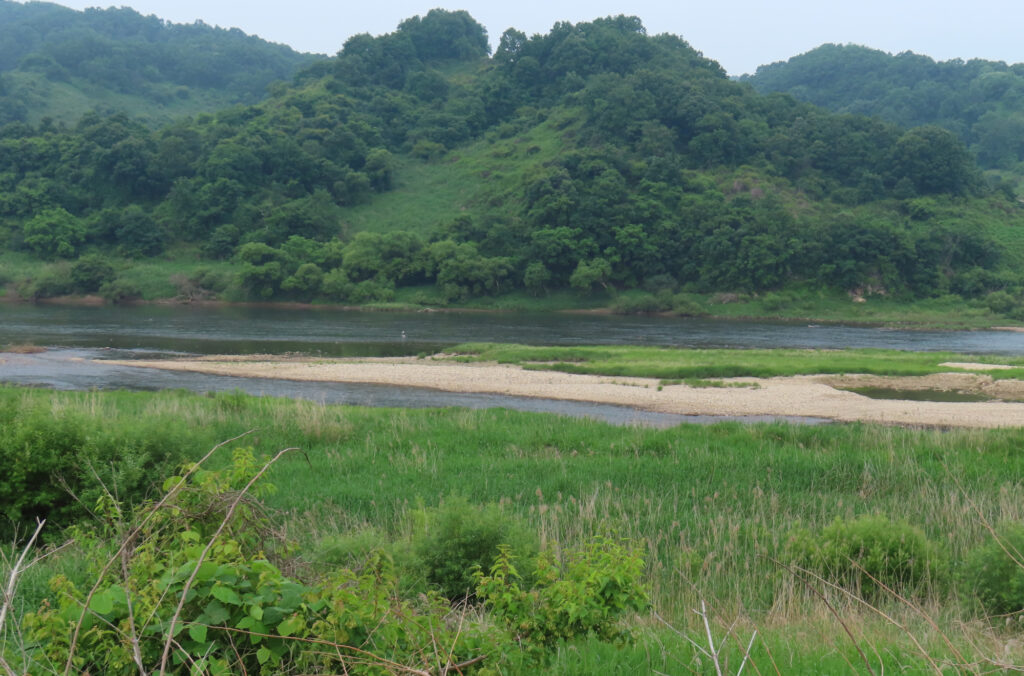


In total we found at least 98 bird species and saw five species of mammal (highlight being an Asian Badger).
New for our survey work in the County were a Purple Heron on 3rd, a displaying Von Shrenck’s Bittern on 8th, and compelling evidence of local breeding by at least two pairs of Yellow-bellied Tits. Numbers of some species (especially raptors) were rather lower than in 2022, perhaps due in part to differences in weather, while higher numbers of some other species were logged, including Yellow-rumped Flycatcher (38 logged this year compared with 21 in 2022) and globally and nationally threatened Fairy Pitta, likely due in part to a larger search area of forest this year.
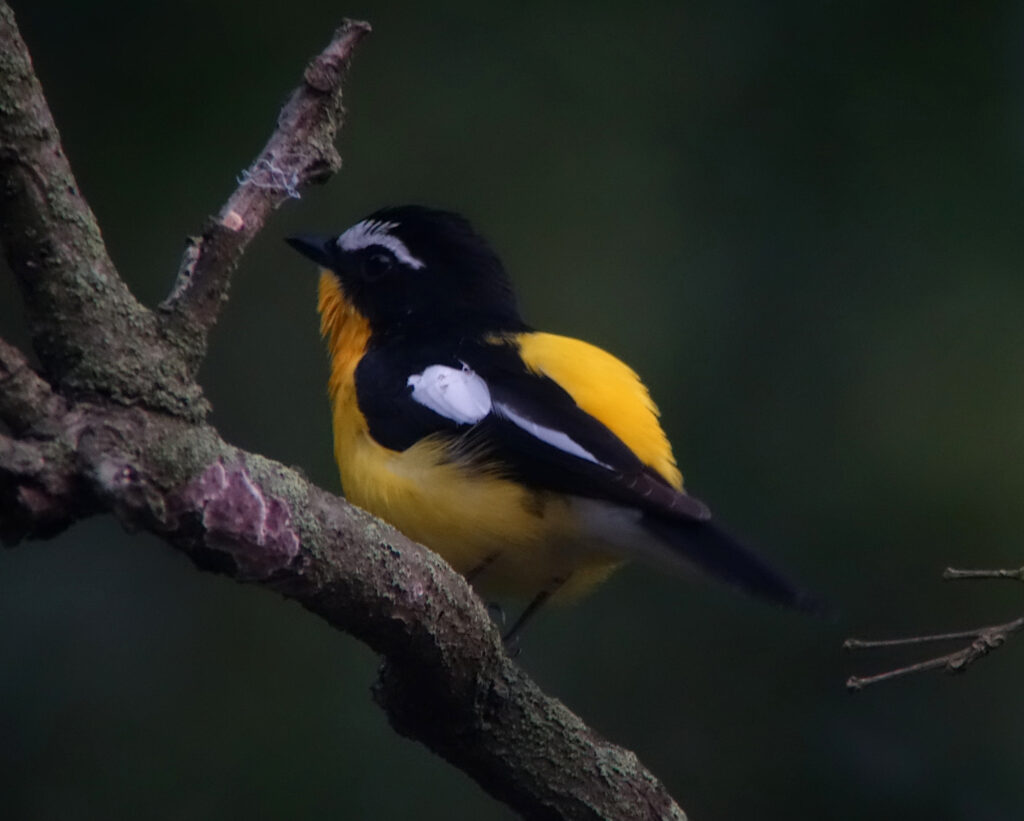
As with other bird and biodiversity surveys funded by Yeoncheon County, much fuller details will be provided in written reports to the County (and will also be made available to our members on request).
A few of the more notable bird species / species of highest conservation concern are listed below:
Taiga Bean Goose Anser fabalis 큰부리큰기러기. A very late flock of 23-25, all presumed to be this species, were seen flying northeast on 3rd; and 5-10 were seen in the Imjin River at Baekhak on 8th, together with 2-7 Tundra Bean Goose Anser serrirostris.


Mandarin Duck Aix galericulata 원앙. In total only 16 were observed – a substantially smaller number than in 2022.
Common Merganser Mergus merganser 비오리. A male was seen on the Imjin River on June 8th. Although this species breeds locally in neighbouring Gangwon Province, this is the first mid-summer record of this species in Yeoncheon County that we are aware of.
Hill Pigeon Columba rupestris 낭비둘기. Six of this nationally Critically Endangered species were seen within the CCZ on 8th.
Watercock Gallicrex cinerea 뜸부기. Similar to last year, two locations were found to hold “gulping” males. Like elsewhere in the ROK, agricultural industrialization continues to reduce habitat for this species even further.

Long-billed Plover Charadrius placidus 흰목물떼새. Our survey was timed too late to develop a proper population estimate for this nationally threatened species. However, young were only observed along the Chatan Stream, and not at two previously favoured sites along the Hantan and at one major site in the Imjin. This was due, in large part, to ongoing “riverworks” (bulldozing areas, including areas used by nesting birds each year, at the height of the breeding season), massive disturbance by “free campers” and recreational fishers, and perhaps also because of high water levels due to pre-Jangma thunderstorms.

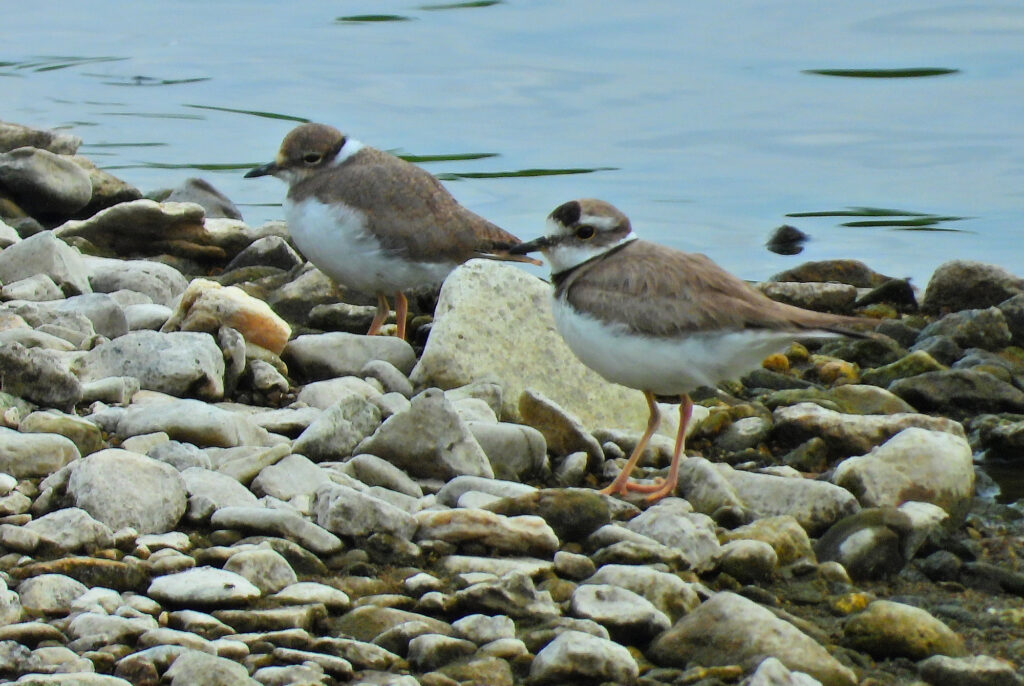
Common Sandpiper Actitis hypoleucos 깝작도요. Although survey of rivers was limited this year, at least 34 were counted in those areas which were visited. No obvious juveniles were seen, however.
Black-tailed Gull Larus crassirostris 괭이갈매기. Although a marine-preferential species, an adult and two Second calendar-years were patrolling the Imjin River at Baekhak on 8th.
Little Tern Sternula albifrons 쇠제비갈매기. One bird was seen and heard in exaggerated display flight over small islands in the Imjin River at Baekhak on 8th. It is unclear whether or not a second bird was also present on the ground, out of view. One pair of this Nationally Vulnerable species were seen nesting in the same area in 2022. However, there was no evidence that any young were fledged.
Von Schrenck’s Bittern Ixobrychus eurhythmus 큰덤불해오라기. A male was watched booming at close quarters in the CCZ on 8th. The whole process vaguely recalled someone playing the bagpipes – first “pumping” to get sufficient air into the instrument (in this case, air sacs on the neck sides), before then releasing sound…To hear this barking boom, please play the video clip below at full volume, preferably with head-phones.



von Shrenck’s Bittern “booming”. Images and Video © Nial Moores
Back in the late 1990s and early 2000s, von Schrenck’s was regular, and even very locally common, at a few sites e.g., on Ganghwa Island and in Cheorwon; and surveys in the mid-late 2010s found decent numbers in DPR Korea. However, in large part due to habitat loss and massive disturbance caused by recreational fishers, this species is now right on the edge of being lost to the ROK as a breeding species.
Purple Heron Ardea purpurea 붉은왜가리. Generally rare in the ROK. An adult was seen well in the CCZ on 3rd.
Chinese Sparrowhawk Accipiter soloensis 붉은배새매. Available evidence suggests that this species is rapidly-declining at both the national and global level. A total of nine were seen during the surveys, most within the CCZ. This compares with 14 seen during our breeding bird survey in 2022.
Northern Goshawk Accipiter gentilis 참매. Only one was seen this year: in the CCZ on 8th.
Grey-faced Buzzard Butastur indicus 왕새매. Six were seen in total, including one pair in display. This compares poorly with the 13 logged in June 2022.
Ruddy Kingfisher Halcyon coromanda 호반새. Eighteen were heard and one was seen. This is remarkably similar to last year’s survey results, even though there were some differences in count areas.
Black-capped Kingfisher Halcyon pileata 청호반새. Now assessed as globally Vulnerable. Formerly fairly widepread in Yeoncheon. Only two were heard, both within the CCZ on 3rd.
Black Woodpecker Dryocopus martius 까막딱다구리. Previously unrecorded during our surveys in Yeoncheon. One probable was heard drumming and then calling distantly in a previously un-surveyed area of forest.
Fairy Pitta Pitta nympha 팔색조. Globally and nationally Vulnerable. A total of 31 or 32 were heard during the survey period, with one bird heard and poorly sound-recorded in direct comparison to three singing Fairy Pitta sounding closer to Blue-winged Pitta Pitta moluccensis (?), in having song phrases which were deeper, perhaps shorter, and lacking upward inflection at the end.

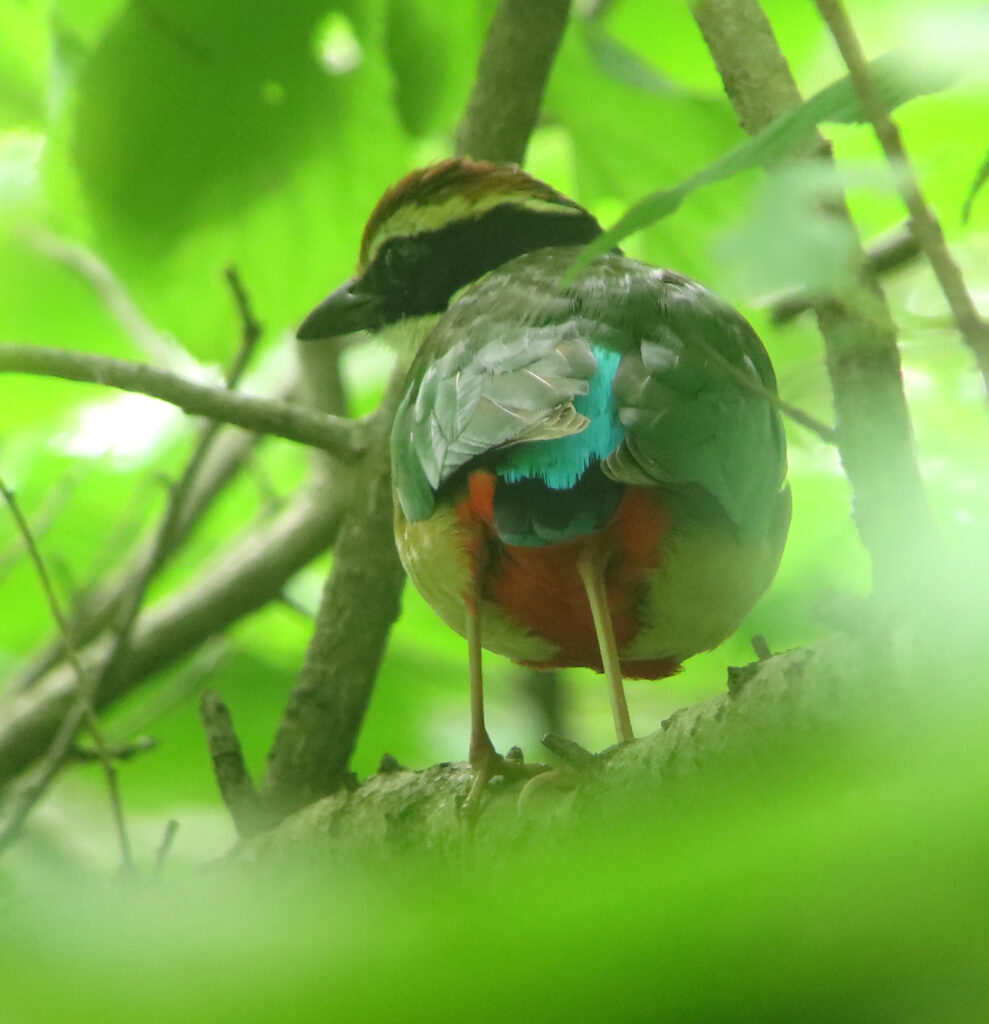

Our survey data provide strong support to our assertion first made last year that Yeoncheon County / the Biosphere Reserve is internationally important for Fairy Pitta. It seems likely that increased survey effort could find 100 or more breeding pairs in the County. More research is required to confirm this, and to understand the specific ecological requirements of local breeders, as these are likely to be subtly different to birds breeding further south in warm broad-leaved evergreen forest, e.g., in eastern Jeju and on Geoje – widely-recognised global breeding strongholds of the species.
Based on available evidence, it seems probable that the ROK as a whole currently supports ~1,000 breeding pairs of Fairy Pitta – either a very substantial part of or perhaps the majority of the global breeding population of this species, estimated by BirdLife International (2023) to be between 1,500 and 7,000 mature individuals. This increased estimate does not mean that Fairy Pitta should be given reduced consideration in domestic Environmental Impact Assessments: quite the opposite. The Fairy Pitta is assessed as being in rapid decline in many other parts of its range (BirdLife International 2023), and although the species in the ROK has likely benefited from reforestation efforts last century and a warming climate, most of the more recent “increase” is likely due to increased observer effort and familiarity with the song.
There are currently insufficient data to identify a national population trend. It is clear, however, that the ROK has an increasingly important role to fulfil in the conservation of the Fairy Pitta at the global level. In spite of this, approval nationwide continues to be given to a whole range of destructive development projects which undoubtedly will cause the species to decline locally, and perhaps globally. Presence of Fairy Pitta during the breeding season really should be sufficient for the national Ministry of Environment and local governments to rule against e.g., road widening; golf course, waste tip and cable car construction in forests; resort development etc. – unless such development can be proven to be genuinely in the interest of the whole nation and unless proper mitigation measures are also put in place in adjacent areas (such as reducing existing levels of human disturbance, and removal of alien invasive species which might predate nests).

Ashy Minivet Pericrocotus divaricatus 할미새사촌. Few documented breeding records in the ROK. Two, or more, appeared to be feeding young in the CCZ on 3rd.
Tiger Shrike Lanius tigrinus 칡때까치. A total of 32 were logged (compared with 38 in June 2022), including one pair watched nest-building.
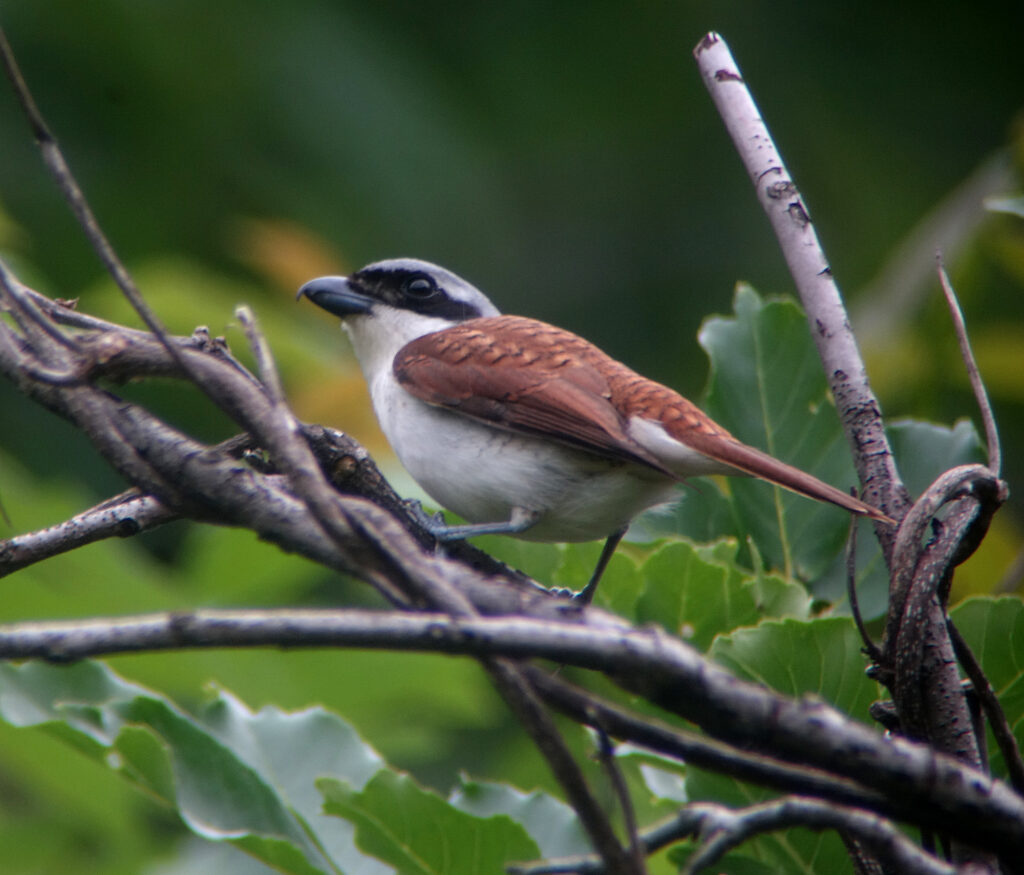
Black Paradise Flycatcher Terpsiphone atrocaudata 긴꼬리딱새. Only one was heard during the present survey. An area where the species was seen last year was not visited.
Carrion Crow Corvus corone 까마귀. A total of nine were seen, including birds in exactly the same fields in the CCZ as in June 2022 and two in Baekhak on 8th. As in 2022, all were seen in rice-fields next to the Imjin River. This total compares to >20 Large-billed Crow logged during the current survey, with several Large-billed seen in closed canopy hill forest. Identification as Carrion Crow based simply on forest mountain habitat – as is often used as the main justification by some observers on eBird – remains wholly unsupported by data from our surveys.
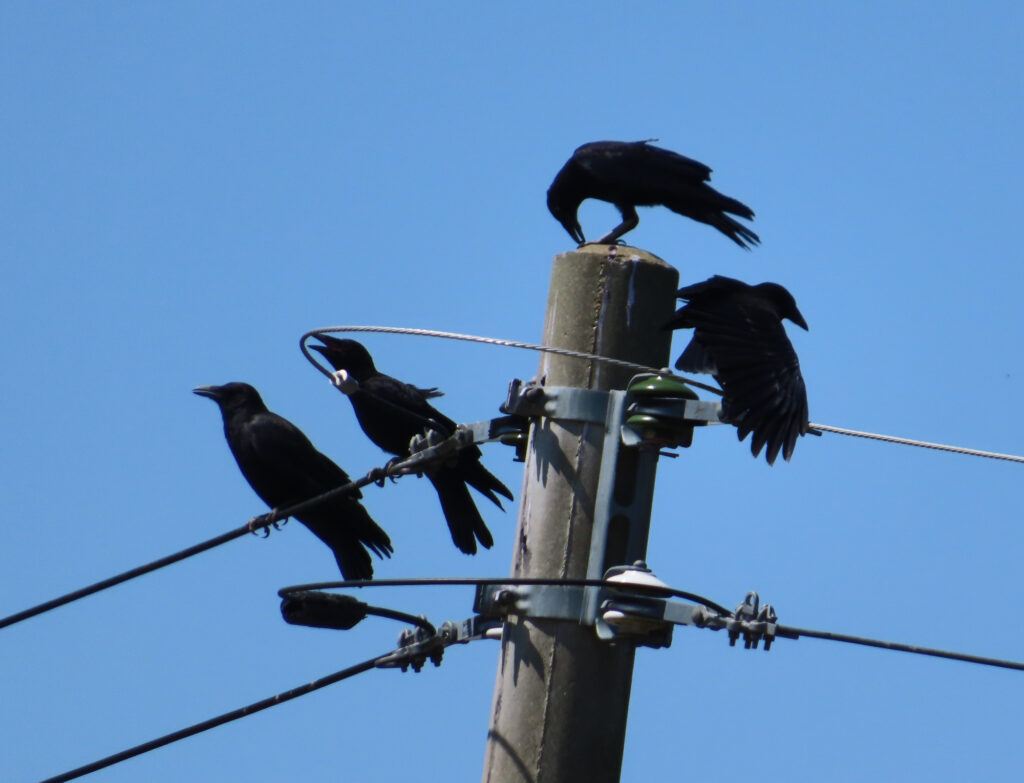
Yellow-bellied Tit Pardaliparus venustulus 노랑배진박새. First recorded in the ROK in 2005, the species continues to increase rapidly, both nationally and throughout the region. At least 16 were logged during the surveys in three different areas of forest, including two family groups (comprised of adults and begging juveniles) and several singing males. This is a substantial increase over last year when two were logged and is only the second or third confirmed national breeding record, after the first, apparently in Yangpyeong (Gyeonggi Province) in 2017.
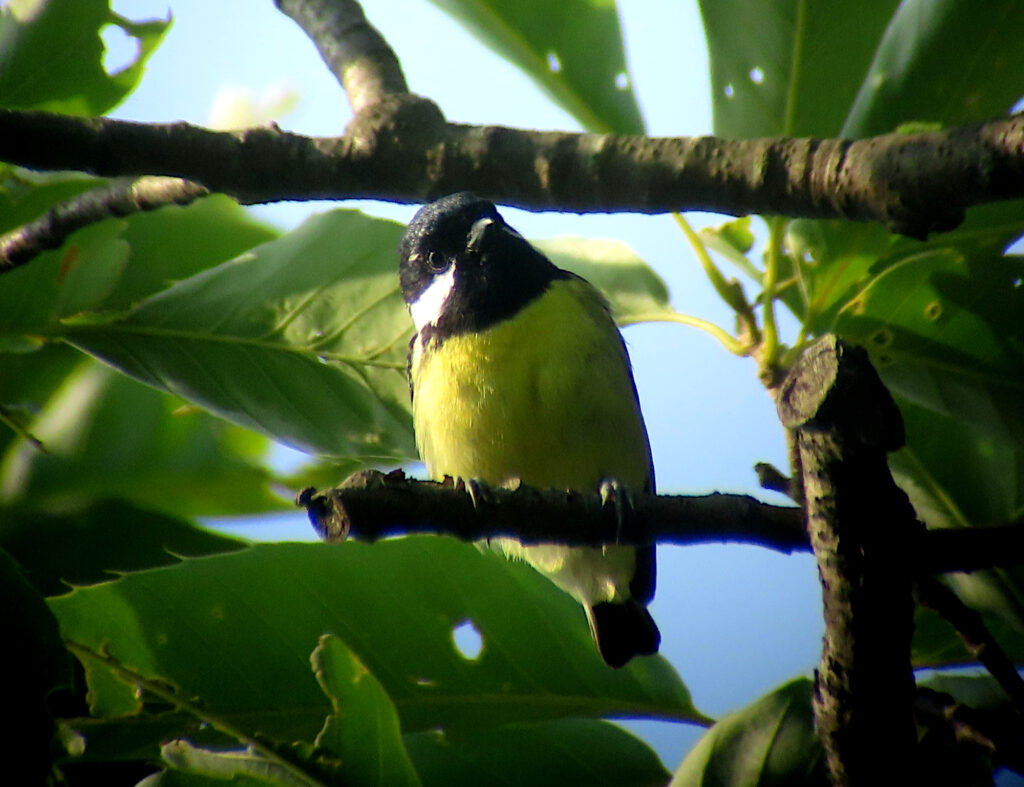
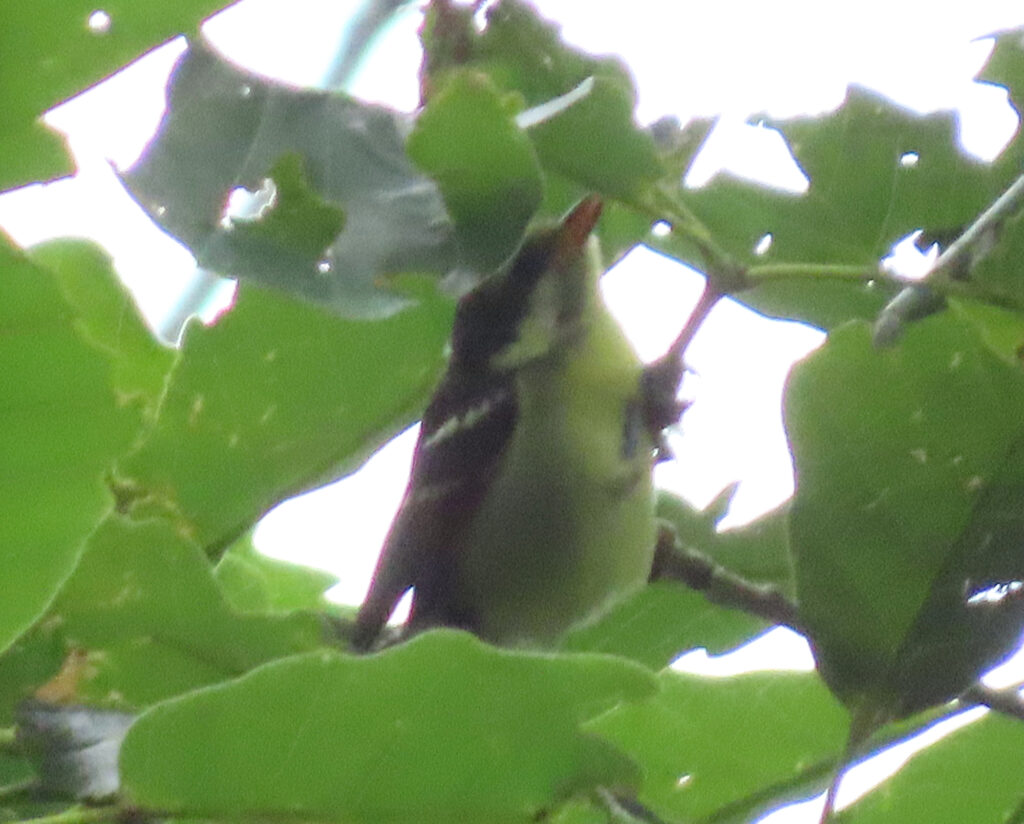
Chinese Penduline Tit Remiz consobrinus 스윈호오목눈이. A male was watched giving brief bursts of song in addition to frequent contact calls in potentially excellent breeding habitat in the CCZ on 3rd. There is only one confirmed national breeding record (on Baengnyeong Island), though it seems likely that the species is over-looked in summer.

Asian Stubtail Urosphena squameiceps 숲새. A total of eleven, mostly singing, birds were logged. Of potential ornithological interest, one was heard and seen calling to what appeared to be a young juvenile on 9th, in forest estimated by a smart phone app to be only c. 45 m asl. It has been suggested that the species only nests above 100 m asl.
Zitting Cisticola Cisticola jundicis 개개비사촌. One was at song at Baekhak on 8th.
Warbling White-eye Zosterops japonicus 동박새. A total of 35 were logged during the surveys, including several well-seen adults and 1-2 family groups. This is a substantial increase over the 11 logged by our surveys in June 2022.
Forest Wagtail Dendronanthus indicus 물레새. One was in song in potentially suitable breeding habitat in the CCZ on 8th.
Finally, this survey period was also really valuable in terms of meetings, with in-office and then in-field meetings with Yeoncheon County’s Tourism department head Park Tae-Won, and Dr Yoo Miyeon; an in-field meeting with Seoul Foreign School teacher Michael Farrant in preparation for a school visit in September; and a small gathering of Birds Koreans on 9th, to discuss progress on “The Spoonbills Project” and the bioblitz program. The latter program will start in mid-June, and will be comprised of ten environmental education sessions of 3-hours each for local residents led by Birds Korea Yeoncheon and Birds Korea members: excellent!

Reference
BirdLife International (2023) Species factsheet: Pitta nympha. Downloaded from http://datazone.birdlife.org/species/factsheet/fairy-pitta-pitta-nympha on 13/06/2023



